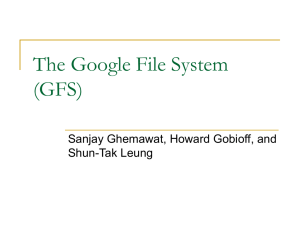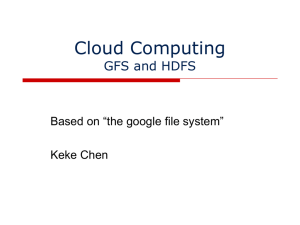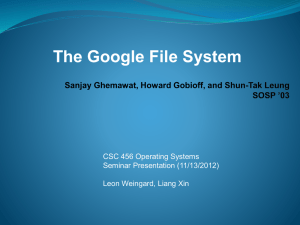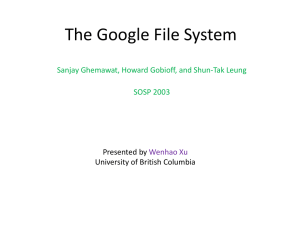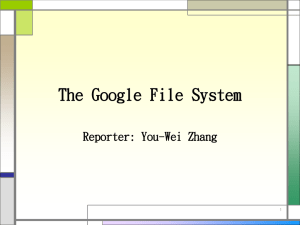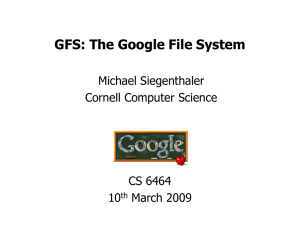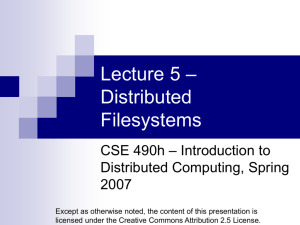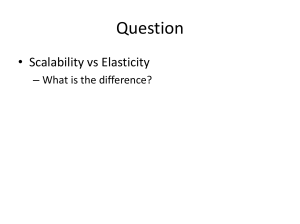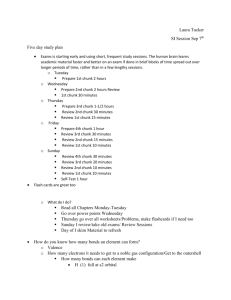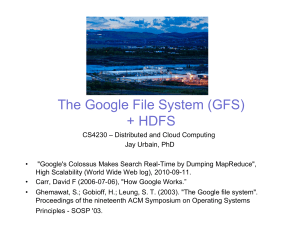GFS
advertisement
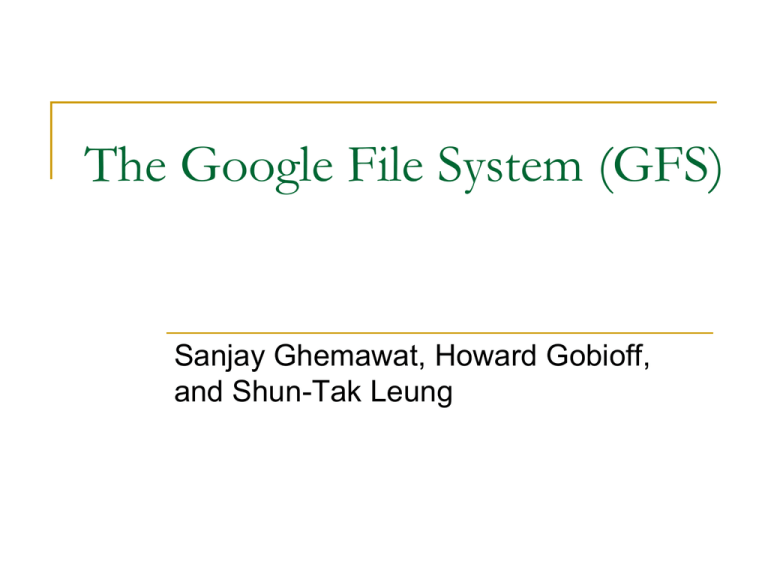
The Google File System (GFS) Sanjay Ghemawat, Howard Gobioff, and Shun-Tak Leung Introduction Design constraints设计要求 Component failures are the norm 1000s of components Bugs, human errors, failures of memory, disk, connectors, networking, and power supplies Monitoring, error detection, fault tolerance, automatic recovery监控,错误检测,容错,自动恢复 Files are huge by traditional standards Multi-GB files are common Billions of objects Introduction Design constraints Most modifications are appends Two types of reads Random writes are practically nonexistent Many files are written once, and read sequentially Large streaming reads Small random reads (in the forward direction) Sustained bandwidth more important than latency 高度可用的带宽比低延迟更加重要 File system APIs are open to changes Interface Design Not POSIX compliant 不遵守POSIX规范 Additional operations Snapshot Record append Architectural Design A GFS cluster A single master 在逻辑上只有一个master Multiple chunkservers per master Accessed by multiple clients Running on commodity Linux machines A file 数据以文件形式存储在Chunk Server上 Represented as fixed-sized chunks(数据块) Labeled with 64-bit unique global IDs Stored at chunkservers 3-way Mirrored across chunkservers Architectural Design (2) Application chunk location? GFS Master GFS client GFS chunkserver chunk data? GFS chunkserver Linux file system GFS chunkserver Linux file system Linux file system Architectural Design (3) Master server Maintains all metadata Name space, access control, file-to-chunk mappings, garbage collection, chunk migration GFS clients Consult master for metadata Access data from chunkservers Does not go through VFS No caching at clients and chunkservers due to the frequent case of streaming 客户端大部分是流式顺序读写,并不存在大量的重复读写,缓存文 件数据对提高系统整体性能的作用不大,服务器不缓存是因为 Linux操作系统会把经常访问的数据存放在内存中 Single-Master Design Simple Master answers only chunk locations A client typically asks for multiple chunk locations in a single request The master also predicatively provide chunk locations immediately following those requested Chunk Size 64 MB Fewer chunk location requests to the master Reduced overhead to access a chunk Fewer metadata entries Kept in memory - Some potential problems with fragmentation碎片 Metadata Three major types File and chunk namespaces文件和数据块的命名空间 File-to-chunk mappings文件到数据块的映射 Locations of a chunk’s replicas数据块副本的位置 Metadata All kept in memory Fast! Quick global scans Garbage collections Reorganizations 64 bytes per 64 MB of data Prefix compression Chunk Locations No persistent states Polls chunkservers at startup Use heartbeat messages to monitor servers Simplicity On-demand approach vs. coordination On-demand wins when changes (failures) are often Operation Logs Metadata updates are logged e.g., <old value, new value> pairs Log replicated on remote machines 多处远程机器上创建日志副本 Take global snapshots (checkpoints) to truncate(截短) logs Memory mapped压入内存 (no serialization/deserialization) Checkpoints can be created while updates arrive Recovery Latest checkpoint + subsequent log files Consistency Model Relaxed consistency Concurrent changes are consistent but undefined An append is atomically committed at least once - Occasional duplications All changes to a chunk are applied in the same order to all replicas 对chunk所有副本的修改操作顺序一致 Use version number to detect missed updates 使用版本号来检测是否由于chunk服务器宕机而丢失某些 更新操作 System Interactions Master节点为Chunk的一个副本建立一个租约, 我们把这个副本叫做主Chunk 主Chunk对Chunk的所有更改操作进行序列化。 所有的副本都遵从这个序列进行修改操作。 Lease 租约 租约的初始超时设置为60秒。不过,只要Chunk被修改了,主Chunk 就可以申请更长的租期,通常会得到Master节点的确认并收到租约延 长的时间。这些租约延长请求和批准的信息通常都是附加在Master节 点和Chunk服务器之间的heartbeat消息中来传递。有时Master节点会 试图提前取消租约(例如,Master节点想取消在一个已经被改名的文 件上的修改操作)。即使Master节点和主Chunk失去联系,它仍然可 以安全地在旧的租约到期后和另外一个Chunk副本签订新的租约 Data Flow Separation of control and data flows 控制流与数据流分离 Avoid network bottleneck Updates are pushed linearly among replicas Pipelined transfers 数据以管道的方式,顺序的沿着一个精心选择的Chunk服 务器链推送。 13 MB/second with 100 Mbps network Snapshot Copy-on-write approach 写时拷贝方法 撤销快照的文件所拥有的chunk的所有租约 New updates are logged while taking the snapshot Commit the log to disk Apply to the log to a copy of metadata A chunk is not copied until the next update Master Operation GFS没有针对每个目录实现能够列出目录下所 有文件的数据结构。GFS也不支持文件或者目 录的链接。 在逻辑上,GFS的名称空间就是一个全路径和 元数据映射关系的查找表。利用前缀压缩,这 个表可以高效的存储在内存中。 Locking Operations 每个Master节点的操作在开始之前都要获得一系列的锁。 通常情况下,如果一个操作涉及/d1/d2/…/dn/leaf,那么 操作首先要获得目录/d1,/d1/d2,…,/d1/d2/…/dn的读 锁,以及/d1/d2/…/dn/leaf的读写锁。注意,根据操作的 不同,leaf可以是一个文件,也可以是一个目录。 采用这种锁方案的优点是支持对同一目录的并行操作。比 如,可以再同一个目录下同时创建多个文件:每一个操作 都获取一个目录名的上的读取锁和文件名上的写入锁。目 录名的读取锁足以的防止目录被删除、改名以及被快照。 文件名的写入锁序列化文件创建操作,确保不会多次创建 同名的文件 Replica Placement 两大目标:最大化数据可靠性和可用性,最大化网络带宽 利用率。 必须在多个机架间分布储存Chunk的副本。这保证Chunk 的一些副本在整个机架被破坏或掉线的情况下依然存在且 保持可用状态。这还意味着在网络流量方面,尤其是针对 Chunk的读操作,能够有效利用多个机架的整合带宽。 每个需要被重新复制的Chunk都会根据几个因素进行排序。 其中一个因素是Chunk现有副本数量和复制因数相差多少。 例如,丢失两个副本的Chunk比丢失一个副本的Chunk有 更高的优先级 Garbage Collection 当一个文件被应用程序删除时,Master节点象对待其它修 改操作一样,立刻把删除操作以日志的方式记录下来。但 是,Master节点并不马上回收资源,而是把文件名改为一 个包含删除时间戳的、隐藏的名字。当Master节点对文件 系统命名空间做常规扫描的时候,它会删除所有三天前的 隐藏文件(这个时间间隔是可以设置的)。直到文件被真 正删除,它们仍旧可以用新的特殊的名字读取,也可以通 过把隐藏文件改名为正常显示的文件名的方式“反删除”。 当隐藏文件被从名称空间中删除,Master服务器内存中保 存的这个文件的相关元数据才会被删除。这也有效的切断 了文件和它包含的所有Chunk的连接( Fault Tolerance and Diagnosis 快速恢复 不管Master服务器和Chunk服务器是如何关闭的,它们 都被设计为可以在数秒钟内恢复它们的状态并重新启动。 Chunk复制 Master复制 GFS中存在一些“影子”Master服务器,这些“影子” 服务器在“主”Master服务器宕机的时候提供文件系统 的只读访问。 处于GFS系统外部的监控进程会在其它的存有完整操作 日志的机器上启动一个新的Master进程。 Fault Tolerance and Diagnosis 数据完整性 我们把每个Chunk都分成64KB大小的块。每个块 都对应一个32位的校验和(checksum)。和其它 元数据一样,Checksum与其它的用户数据是分开 的,并且保存在内存和硬盘上,同时也记录操作日 志。 在Chunk服务器空闲的时候,它会扫描和校验每个 不活动的Chunk的内容。这使得我们能够发现很少 被读取的Chunk是否完整。
